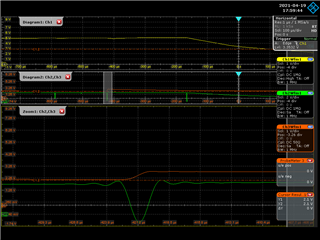Hi Team,
My customer is seeing an issue in their system while running off of our internal battery where under high system loads, high loads on our 5V rail (supplied by a TPS54821), and low battery state-of-charge, they see the 5V rail brown-out.
Probing the board, we believe that we’re hitting the BOOT-PH UVLO. (see attached, CH1: output, CH2: PH CH3: BOOT-PH)
What’s unclear to us reading the data sheet, though, is under what conditions, we should expect to hit the BOOT-PH UVLO—can you provide some guidance for what we should consider a comfortable input voltage to avoid it?
Thanks,
Mitchell

